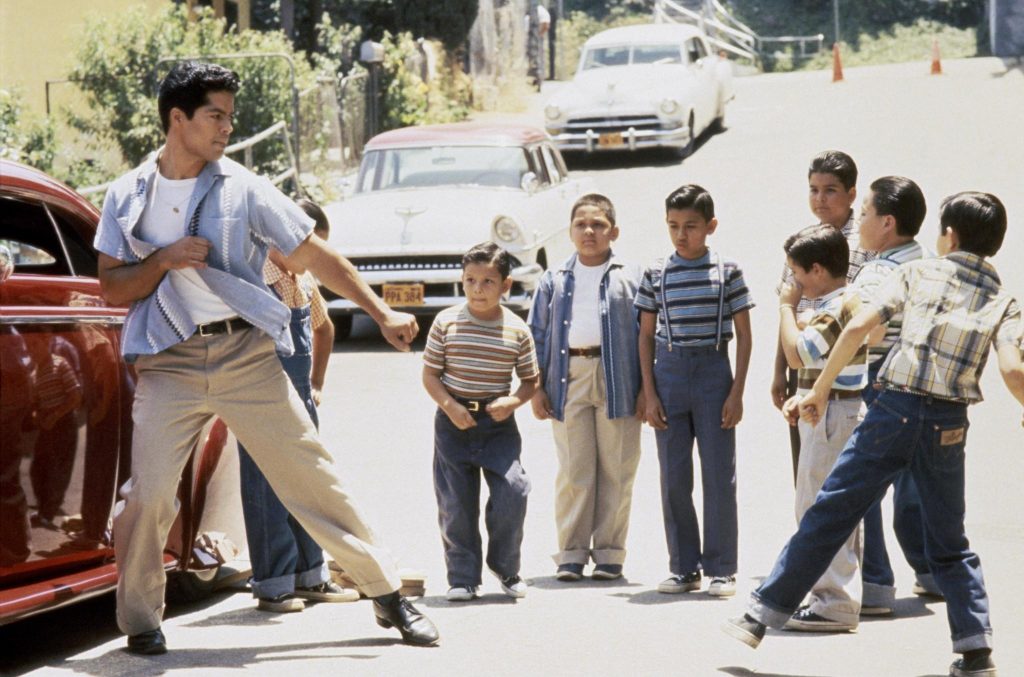 1. El Pueblo Nuestra Señora Reina de Los Angeles: according to some historians this was an early name for Los Angeles.”
1. El Pueblo Nuestra Señora Reina de Los Angeles: according to some historians this was an early name for Los Angeles.”
2. Jalisco and Colima: States in Mexico.
3. Andale, can cuidado: Come on with care.
4. Hazle un lugar ahi: Make a place for him there.
5. Niños: children.
6. Tu café con leche está listo:Your coffe with milk is ready.
7. Mi cafecito: My coffee.
8. La Migra: The Immigration and Naturalization Service (now called the U.S. Citizenship and Immigration Service, “USCIS”).
9. Por favor, Señor: Please, mister.
10. Pinche: ***.
11. Pachuco: a male member of a Mexican-American subculture in the 1930s to 1950; pachucos wore zoot suits, had an exuberant nightlife, and engaged in flamboyant public behavior; some were associated with street gangs.
12. hermano, hermana: brother, sister.
13. aboratte*: colloquial for “go away,” “leave,” “disappear yourself.”
14. Cholo: a person who is of mixed Spanish and native American heritage; a half-breed; it is often pejorative.
15. Ese: slang to refering to the person you are talking to; it is often seen as a perjorative reference to a person of Hispanic heritage.
16. Pues nada: well, nothing.
17. Apurate: hurry up (When Irene says this to her sister Toni, she is being sarcastic.)
18. Machismo: male chauvinism.
19. Brindis: a toast;
20. Felicidades: congratulations;
21. Ella es la mama: She is the mother.
22. No te hagas rogar: You don’t have to beg.
23. Salud: To your health.
24. Salud a todos: To everyone’s health.
25. Mariachi: a form of folk music from Mexico.
26. Los apostoles: The Apostles.
27. Puta, puto: prostitute; when referring to a man it is a general insult.
28. Que Pasa: What’s going on?
29. Vato: Dude.
30. Carnal, carnala: buddy, relative.
31. Que te metas para adentro: What did I say about staying inside?
32. Milpa: cornfield.
33. Chavalito: little boy.
34. Jefe: boss, leader, chief, commander; in a family, Father; Jefecita is Mother.
35. Mota: slang for marijuana.
36. No es tiempo para esto: This is not the time for this.
37. Sinverguenzas delincuentes:criminals
38. Pero tu . . . . : But you . . . .
39. No tienes consciensia: You have no conscience.
40. No tienes dignidad: You have no dignity.
41. A la chingada con eso!: F..k that!
42. No hagas esto, mijo: Don’t do this, son.
43. No hagas esto: Don’t do this.
44. Largate: Get out of here.
45. Que estas haciendo: What are you doing?
46. Mijo: Son.
47. Chinga tu madre.: F__k you.
48. Y mi jefita, como está?: How is mother doing?
49. Y mi jefe, qué dice?: And Dad, what does he say?
50. Nada: nothing.
51. Vete: Get out of here.
52. Hasta Mañana: Until tomorrow.
53. Apurate: Hurry up.
54. Mira: Look at.
55. Con permisso: Excuse me.
56. Vas a ver:You’ll see.
57. Quadese ahi: Stay there.
58. Está muerto: He is dead.
59. La pinta*: slang for prison.
60. Hola: Hello or Hey there.
61. Callate: Be quiet, Shut up.
62. Hijo de: Son of . . . .
63. Un Sacerdote: a priest.
64. mi vida: my life, my darling
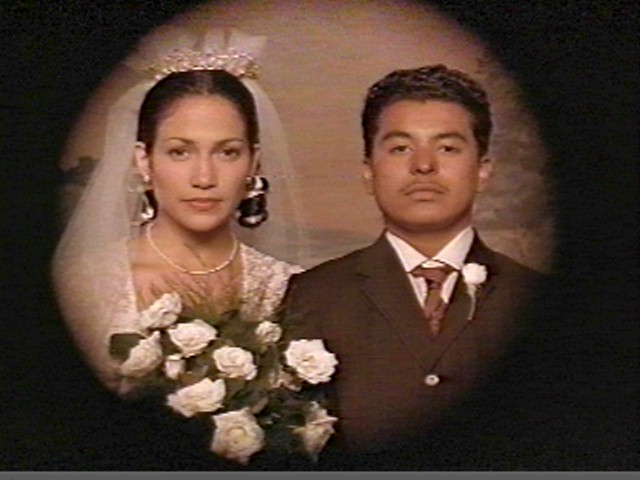 65. Mucho gusto: nice to meet you.
65. Mucho gusto: nice to meet you.
66. Mi querido: my darling
67. Y (as in “Y Paco”: and.
68. Abogado: lawyer.
69. Hombre: lman.
70. Mujer: woman.
71. Hombre y mujer, ¿sabes?: Man and woman, understand?
72. Pero: but.
73. Este pastel esta muy bueno: This cake is very good.
74. Baboso: lovestruck, drooling, fawning.
75. Ruca: Old maid.
76. Pendejo: jerk, coward.
77. Cabrona: bitch.
78. Es la pura verdad: It is the pure truth.
79. Vos tenes que ayudarme: You have to help me.
80. Me acabo de casar y no se adonde voy a ir: I just got married and I don’t know what I’m going to do.
81. ¿Vos sabes dodne está Jimmy?: Do you know where Jimmy is?
82. No puede creer esto: I can’t believe this.
83. Ya lo llame: I’m going to call him now.
84. ¿Que Voy a hacer?: What am I going to do?
85. Oye: Hey.
86. Ven acá, hijo: Come here, son.
87. Explícame qué pasa aqui: Explain to me what’s going on here.
88. Chingao: f__cked up.
89. Ay, Dios: Oh, God.
90.Porqueria politica: political crap.
91. Sagradas: sacred.
92. Y tu te callas: And you shut up.
93. Te fregaste: You messed up.
94. No quiero: I don’t want.
95. Vato loco: Crazy dude.
96. Canton: lang for a house in the barrio.
97. Viva la Raza: Long live the mestizo race.
98. Entonces qué: Then what.
99. ¿Eres mi hombre?: Are you my man?
100. ¿Si o no?: Yes or no?
101. Te regalo una rosa: I give you a rose.
102. Si, vamos: Yes, let’s go.
103. No se si esta desnuda: I dont know if it’s naked.
104. O tiene un solo vestido: or just one dress — this line and line # * are from the album “Bachata Rosa” by Juan Luis Guerra.
105. ¿Que dolor, no?: It was painful, wasn’t it?
106. Grandissima ciudad: Big city.
107. Los soldados: the soldiers.
108. Ay, imuchacho travieso, sinverguenza: mischevious scoundrel — can’t find a meaning for “imuchacho.”
109. Ven aqui: come here.
110. Te voy a pegar Mocoso: You brat. I’m going to spank you.
111. Mocoso, ya veras: Sntty nosed squirt, you will see.
112. Muchacho malcriado, ahora veras: spoiled boy, now you will see.
113. ¿Que pasa aqui, senora?: What’s going on here, Senora?
114. Pero ese nino es un desgraca: But, that child is a disgrace.
115. Abuelita, Abuelito: grandmother, grandfather.
116. te voy a comer vivo, vas a ver: I’m going to eat you alive, you’ll see.
117. Mucha hierba: a lot of grass.
118. Es que no puede, jefe: This can’t be done, Dad.
119. ¿Si, mi Chapulin?: What is it my grasshopper?
120. Hola, mi amor. ¿Ququé haces?: Hello, my love, what are you making? or Hello, my love, what are you doing?
121. Calma: calm down.
122. Escucha a Mami: Listen to mother.
123. Lo siento, mijo: I’m sorry, son.
124. Salud: Cheers.
125. Qué pasa: What’s up?
126. Tu café con leche está listo:Your coffe with milk is ready.
127. Vamos hombre. Andale: Go man, hurry.
128. Andae: Come on.
129. Mi familia: My family.

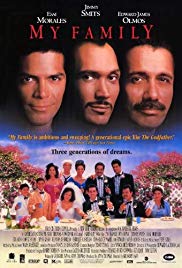

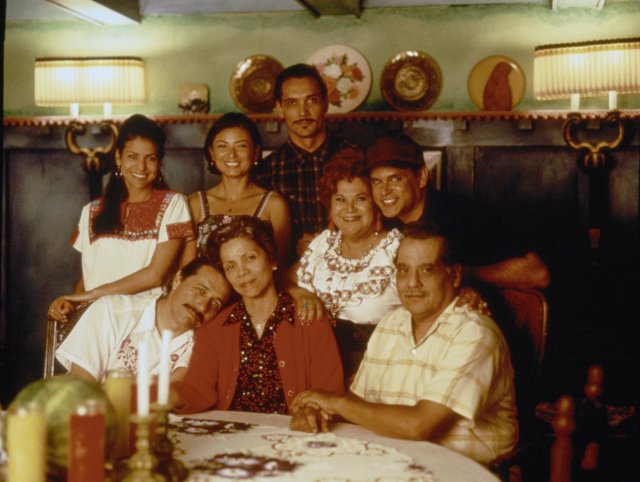
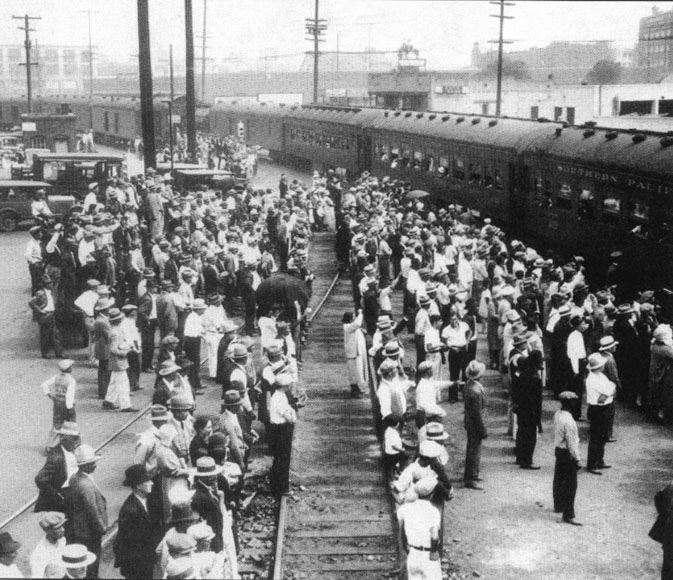
 1. El Pueblo Nuestra Señora Reina de Los Angeles: according to some historians this was an early name for Los Angeles.”
1. El Pueblo Nuestra Señora Reina de Los Angeles: according to some historians this was an early name for Los Angeles.” 65. Mucho gusto: nice to meet you.
65. Mucho gusto: nice to meet you.